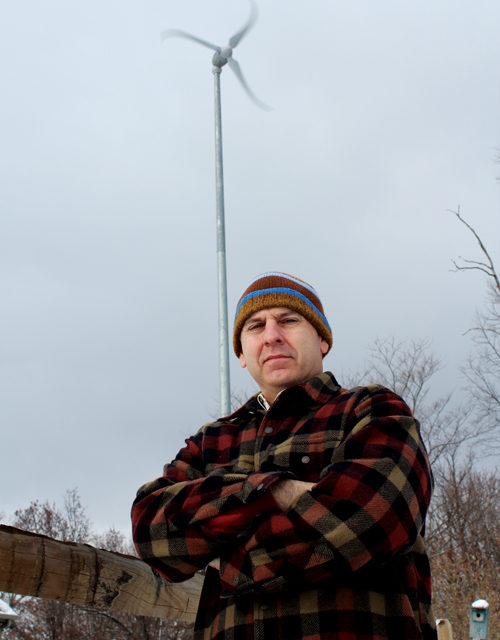
Todd Bricken, owner of the Brick Ridge Restaurant, had a wind turbine installed because it made economic sense.
Written By Donna Engle, Photos by: Crystal Griffiths
A wind turbine at Brick Ridge Restaurant near Mount Airy sends electricity into the restaurant with every turn of its blades. Owner Todd Bricken installed it because investment in alternative energy made economic sense, and because it put his money where his heart is.
Bricken weighed utility costs against tax credits and available grants before deciding to invest in wind power. But he also has a lifelong credo of using resources wisely. Use of alternative energy places his restaurant among Carroll businesses and farms pioneering off-grid technologies.
At Sunnyside Farms, Westminster, the largest ground-mounted solar array on a Maryland farm helps produce power to feed and water 400,000 chickens and keep henhouse temperatures comfortable; at Serra Valley Farms, Mount Airy, two wind turbines provide enough daily power to burn 280 100-watt light bulbs, and at Kohl’s Eldersburg department store, 1,500 rooftop solar panels supply 40 percent of the store’s energy.
“The reason for recycling and reusing is just common sense,” Bricken said. He grew up on a family farm where nothing was wasted, so when he bought the restaurant 10 years ago, it was natural for him to compost its garbage. Three years ago, he began looking into wind power.
Bricken’s timing was in line with Maryland’s goal to have power companies serving the state generate 20 percent of their electricity from green sources by 2022. To jump-start residential and commercial use of alternative power, the Maryland Energy Administration (MEA) awarded $426,000 in grants from July 1, 2009 through December 1, 2010. The grants helped fund energy production from wind, solar hot water, solar voltaic and geothermal sources, according to Ian Hines, MEA communications director. Businesses can also take a one-time federal incentive tax credit of 30 percent of an alternative energy project’s tax basis.
Government incentives bring the average payback period down to five to eight years for wind turbines, said Craig McQuinn, project manager for Banner Home Solutions, Mount Airy, which installed the $29,000 turbine at Brick Ridge.
The payback will be longer for Bricken. Based on the turbine’s current average production of three kilowatts a day, he estimates the payback at 20 years. But Bricken is getting a benefit he hadn’t anticipated: positive comments from customers. “It’s great for a small business, because customers like to see the [alternative energy] equipment,” he said.
Bricken is working with a consultant on solar collectors, planned for installation this year. The collectors will provide hot water and may also help heat and cool the 1,800 square foot restaurant.
At Sunnyside Farms, it takes an average 980,000 kilowatt hours of electricity a year to ventilate the chicken houses, operate automatic feed and water dispensers and keep eggs cooled to 45 degrees in storage.
“We’re basically trying to make an ideal climate for the birds,” said Brad Rill, vice-president of Lippy Brothers, Inc., which owns the farm. As discounts and reduced corporate rates for electricity began to phase out three years ago, Lippy Brothers looked for ways to cut operating costs.
An energy audit led Sunnyside to adopt measures such as lower wattage light bulbs. The measures yielded some cost savings, Rill said, but management decided to investigate solar and wind power generation.
“We initially looked at wind, but after looking at the grants and incentives for solar, financially and for the longevity of the system, solar was the best option for them,” said Ken Donithan, owner and chief power engineer of Earth and Air Technologies, Hampstead, the project contractor.
To advise customers, Donithan determines how much of a customer’s power usage he wants alternative sources to produce. In simplified terms, the more solar modules you install, the more electricity you can generate, he said.
At Sunnyside, the 935 solar modules that went into operation in October 2010 are expected to produce 240,000 kilowatts of electricity a year, approximately 25 percent of the farm’s power usage. The system is tied to the grid and net metered, which means that when the solar array produces more electricity than the farm is using, the electric meter runs backward and Sunnyside receives a credit from the utility.
“Everyone was kind of going into the unknown with this,” Rill said. So far, the solar array is producing slightly more power than projected, he said.
Payback on the $882,000 solar array is projected at five years. It was financed partly with a $225,000 United States Department of Agriculture grant and a $50,000 state grant.
Grants, incentives and tax credits make investments in alternative power cost-effective, Donithan said. “If you have the money, now’s the time to do it, because grants are at the maximum. Without the incentives, it won’t be cost-effective unless the technology costs come down,” he said.
Serra Valley Farms invested in wind power three years ago to deal with the horse farm’s “astronomical electric bills,” said Lanie Gould, wife of owner Lou Gould. The turbines help keep an indoor arena, barn and stables lit for year-round riding classes and competitions in show jumping and dressage.
Feedback from the public has been positive. “Many people seem to love the idea that we’re using the windmills,” Lanie Gould said.
Installation of the rooftop solar array at Kohl’s Eldersburg store in September 2009 was part of the retail chain’s plan to use energy as efficiently as possible at its 1,089 stores. In a statement, the company said that Kohl’s national energy management program has saved an estimated $50 million in electricity costs since it began in 2007.
Expansion of the solar program to other stores will be done, “where it is feasible, profitable and provides a cost savings to Kohl’s,” said spokeswoman Christie Wolf.

